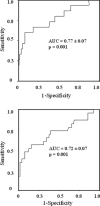Fragmented QRS in prediction of cardiac deaths and heart failure hospitalizations after myocardial infarction
- PMID: 20522053
- PMCID: PMC6932707
- DOI: 10.1111/j.1542-474X.2010.00353.x
Fragmented QRS in prediction of cardiac deaths and heart failure hospitalizations after myocardial infarction
Abstract
Background: Increased QRS fragmentation in visual inspection of 12-lead ECG has shown association with cardiac events in postmyocardial infarction (MI) patients. We investigated user-independent computerized intra-QRS fragmentation analysis in prediction of cardiac deaths and heart failure (HF) hospitalizations after MI.
Methods: Patients (n = 158) with recent MI and reduced left ventricular ejection fraction (LVEF) were studied. A 120-lead body surface potential mapping was performed at hospital discharge. Intra-QRS fragmentation was computed as the number of extrema (fragmentation index FI) in QRS. QRS duration (QRSd) was computed for comparison.
Results: During a mean follow-up of 50 months 15 patients suffered cardiac death and 23 were hospitalized for HF. Using the mean + 1 SD as cut-point both parameters were univariate predictors of both end-points. In multivariate analysis including age, gender, LVEF, previous MI, bundle branch block, atrial fibrillation, and diabetes FI was an independent predictor for cardiac deaths (HR 8.7, CI 3.0-25.6) and HF hospitalizations (HR 3.8, CI 1.6-9.3) whereas QRSd only predicted HF hospitalizations (HR 4.6, CI 2.0-10.7). In comparison to QRSd, FI showed better positive (PPA) and equal negative (NPA) predictive accuracy for both end-points, and PPA was further improved when combined to LVEF < 40%. Limiting fragmentation analysis to 12-lead ECG or a randomly selected 8-lead set instead of all 120 leads resulted in an almost similar prediction.
Conclusions: Increased QRS fragmentation in post-MI patients predicts cardiac deaths and HF progression. A computer-based fragmentation analysis is a stronger predictor than QRSd.
Figures




Similar articles
-
Increased intra-QRS fragmentation in magnetocardiography as a predictor of arrhythmic events and mortality in patients with cardiac dysfunction after myocardial infarction.J Cardiovasc Electrophysiol. 2006 Apr;17(4):396-401. doi: 10.1111/j.1540-8167.2005.00332.x. J Cardiovasc Electrophysiol. 2006. PMID: 16643362
-
QRS duration in high-resolution methods and standard ECG in risk assessment after first and recurrent myocardial infarctions.Pacing Clin Electrophysiol. 2006 Aug;29(8):830-6. doi: 10.1111/j.1540-8159.2006.00448.x. Pacing Clin Electrophysiol. 2006. PMID: 16922998 Clinical Trial.
-
QRS duration predicts death and hospitalization among patients with atrial fibrillation irrespective of heart failure: evidence from the AFFIRM study.Europace. 2014 Jun;16(6):803-11. doi: 10.1093/europace/eut335. Epub 2013 Dec 23. Europace. 2014. PMID: 24368753 Free PMC article. Clinical Trial.
-
Size Matters: Normalization of QRS Duration to Left Ventricular Dimension Improves Prediction of Long-Term Cardiac Resynchronization Therapy Outcome.Circ Arrhythm Electrophysiol. 2018 Dec;11(12):e006767. doi: 10.1161/CIRCEP.118.006767. Circ Arrhythm Electrophysiol. 2018. PMID: 30541355
-
Ventricular Depolarization Abnormalities and Their Role in Cardiac Risk Stratification - A Narrative Review.Rev Cardiovasc Med. 2025 Jan 9;26(1):25921. doi: 10.31083/RCM25921. eCollection 2025 Jan. Rev Cardiovasc Med. 2025. PMID: 39867187 Free PMC article. Review.
Cited by
-
The independent relationship of systemic inflammation with fragmented QRS complexes in patients with acute coronary syndromes.Korean Circ J. 2012 Jul;42(7):449-57. doi: 10.4070/kcj.2012.42.7.449. Epub 2012 Jul 26. Korean Circ J. 2012. PMID: 22870078 Free PMC article.
-
Total Mortality, Major Adverse Cardiac Events, and Echocardiographic-Derived Cardiac Parameters with Fragmented QRS Complex.Ann Noninvasive Electrocardiol. 2016 Jul;21(4):404-12. doi: 10.1111/anec.12325. Epub 2015 Nov 2. Ann Noninvasive Electrocardiol. 2016. PMID: 26523941 Free PMC article. Review.
-
Predictive value of the fragmented QRS complex in 6-month mortality and morbidity following acute coronary syndrome.Int J Gen Med. 2013 May 28;6:399-404. doi: 10.2147/IJGM.S40050. Print 2013. Int J Gen Med. 2013. PMID: 23761979 Free PMC article.
-
An automated algorithm for online detection of fragmented QRS and identification of its various morphologies.J R Soc Interface. 2013 Oct 16;10(89):20130761. doi: 10.1098/rsif.2013.0761. Print 2013 Dec 6. J R Soc Interface. 2013. PMID: 24132202 Free PMC article.
-
Association between resolution of fragmented QRS and response to cardiac resynchronization therapy.Ann Noninvasive Electrocardiol. 2015 Mar;20(2):126-31. doi: 10.1111/anec.12186. Epub 2014 Jul 7. Ann Noninvasive Electrocardiol. 2015. PMID: 25039278 Free PMC article.
References
-
- Torabi A, Cleland JGF, Khan NK, et al The timing of development and subsequent clinical course of heart failure after a myocardial infarction. Eur Heart J 2008;29:859–870. - PubMed
-
- Lewis EF, Velazques EJ, Solomon SD, et al Predictors of the first heart failure hospitalization in patients who are stable survivors of myocardial infarction complicated by pulmonary congestion and/or left ventricular dysfunction: A VALIANT study. Eur Heart J 2008;29:748–756. - PubMed
-
- The SOLVD Investigators . Effect of enalapril on survival of patients with reduced left ventricular ejection fractions and congestive heart failure. N Engl J Med 1991;325:293–302. - PubMed
-
- Bristow MR, Saxon LA, Boehmer J, et al Cardiac‐Resynchronization therapy with or without an implantable defibrillator in advanced chronic heart failure. N Engl J Med 2004;350:2140–2150. - PubMed
Publication types
MeSH terms
LinkOut - more resources
Full Text Sources
Other Literature Sources
Medical
Research Materials
Miscellaneous

